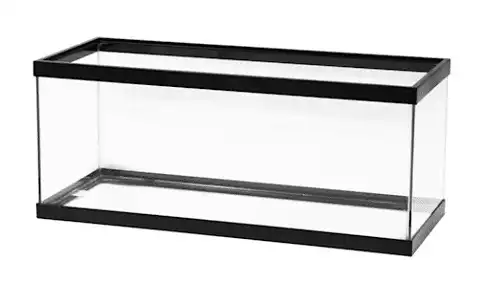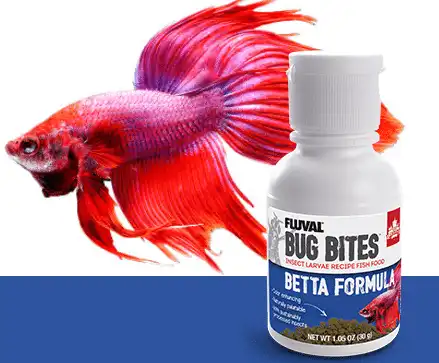Thank you for visiting! By the way… any links on this page that lead to products on Amazon and other stores/partners are affiliate links Aquarium Store Depot earns a commission if you make a purchase.
Halfmoon betta fish is the most stunning aquarium fish with a tail span of 180 Degrees that forms a D shape. However, not every half-circle tail is a Halfmoon strain. In this article, I’ll discuss everything in this halfmoon betta care guide and what defines a true halfmoon betta.
Stay with me to blow your mind.
Species Overview
| Scientific Name | Betta splendens |
| Common Names | Halfmoon Betta Fish, Moon Betta, Siamese Fighting Fish |
| Family | Osphronemidae |
| Origin | Thailand |
| Diet | Omnivore |
| Care Level | Intermediate |
| Activity | Slow to Moderate |
| Lifespan | 2 – 5 years |
| Temperament | Peaceful (Aggressive to own kind) |
| Tank Level | Middle to top |
| Minimum Tank Size | 5 gallon |
| Water Temperature Range | 76°-81°F |
| Water Hardness | 5 to 20 DH |
| pH Range | 6.5 – 8.0 (for most varieties) |
| Filtration/Water Flow | Low |
| Water Type | Freshwater |
| Breeding | Egg-layer |
| Difficulty to Breed | Easy to breed |
| Compatibility | Community fish (when with other species) |
| OK, for Planted Tanks? | Yes |
What Is A Halfmoon Betta Fish?
Halfmoon betta fish or Siamese fighting fish are popular freshwater fish, famous for their unique “half-moon” tail that fans out into a semi-circle with a full 180 degrees.
Like other betta fish, Halfmoon bettas are known for their beautiful finnage and vibrant colors, and unique patterns that make them noticeable creatures in your fish tank. Like other betta fish strains, including Deltas and Super Delta, the halfmoon betta has large fins and D-shaped tails.
These fish species are prone to fin rot, so ideal water quality should be maintained to avoid any health hazards. Since their long flowing tails carry so much weight, you might catch your half-moon bettas biting their own fins.
What’s A True Breed
Many novice aquarists confuse all the betta fish with a half-circle tail to be halfmoon betta. However, that’s not the case. There’s so much more to the true identity of a halfmoon betta than just the tail shape.
The true definition of a halfmoon betta is the one that creates an entire circle where the dorsal fin, anal fin, and caudal fin overlap each other and make a complete circle. Also, the caudal fin of the Halfmoon betta fish shield flares out beyond 180 degrees to be considered true half-moons. Experts suggest the best halfmoon betta fish have straight caudal fins edges—but this condition is rare since many breeders fail to meet this requirement.
In short, the caudal fins of a true halfmoon betta fish should form a perfect D in full flare and the sides should be absolutely vertical and create a clean corner with the outside edge. The irony is, halfmoon bettas do not produce true offspring, even if two true halfmoon betta breed, only a very small proportion of the offspring will have real half-moon tails.
Origin & Habitat
The existence of Bettas is as old as human civilization. But, they became the talk of the town in the 19th century when gambling on fish fights was at its peak. Particularly, male bettas were widely used among Thai and Malay people for fighting purposes.
Halfmoon bettas are selectively bred varieties of the very popular Siamese fighting fish. Originally, they are from Southeast Asia, whereas the original bettas are usually from the Mekong basin of Thailand, Laos, and Cambodia. Since their natural habitat is shallow, slow-moving waters, they prefer water conditions
Halfmoon bettas are a selectively bred variant of the Siamese Fighting Fish (Betta splendens), which originate from Southeast Asia. The original betta species are found in the Mekong basin in countries such as Thailand, Laos, Cambodia, and Vietnam. Their natural habitats are typically shallow, slow-moving waters such as rice paddies, marshes, ponds, and slow streams.
Today, half-moon betta is a popular freshwater fish in the fishkeeping industry, including the white half-moon betta and albino varieties.
Appearance

Halfmoon betta fish is a beautiful variant of the most popular betta fish with exotic colors and a stunning appearance with an exquisite display of fins and tails. They have the unique semi-circular shape of fins and tails that fans out like a half-moon, like their name. When the fins are in their full flare, they should spread out and form a perfect 180 degrees, in the shape of the letter, D.
The tails and fins are two of the most distinguishable characteristics of the Halfmoon betta. They have large fins that are long and flowy with clean and sharp edges. These fish species come in a variety of colors and patterns. You will find them in solid colors, marbled patterns, and multicolored variants—all look beautiful and elegant. However, some popular colors in Halfmoon betta are red, blue, black, white betta, metallic, and other iridescent varieties.
Like most fish, the male halfmoon bettas are more vibrant and have longer fins than their female halfmoon betta counterparts.
How Big They Can Get?
When fully grown and developed, the average size of halfmoon betta is around three inches.
Lifespan (How Long Do They Live?)
The average lifespan of Halfmoon bettas depends on the water quality and other water conditions and parameters. However, under optimal conditions, the life expectancy of Halfmoon Betta is between two and four years.
Types
There are several types of Halfmoon betta that differ from one another in terms of appearance.
Plakat

If true halfmoon betta baffles you for their long, high-maintenance fins and tail, you should definitely check out the Plakat version. Also known as HMPK in the trade, these fish species have shorter fins that fan out to 180 degrees, just like the standard halfmoon betta. However, the risk of fin rot is less likely than other halfmoon betta fish.
Plakats are Betta species that were first found in Thailand with red, black, and blue coloration. However, today, they are available in various tail types, including Crowntail, Doubletail, Halfmoon, and others. They are active fish that do pretty well in a 10+ gallon tank. They are also known as been more aggressive than other betta types, so make sure they have plenty of space.
Dumbo
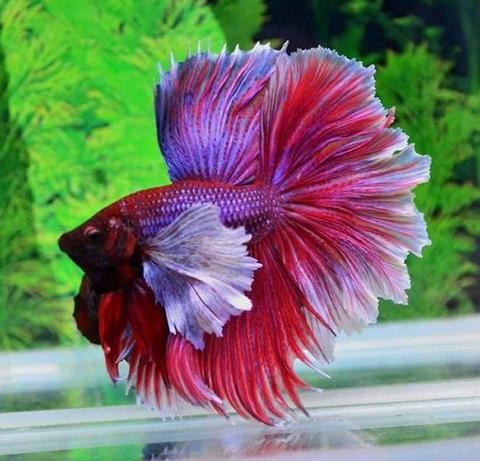
Dumbo betta or Elephant ear betta is a specially bred betta. These betta fish have a unique characteristic of huge pectoral fins, that resemble the Elephant’s ears. Hence, the name. Like other bettas, Dumbo bettas display a wide range of colors and patterns that grace your home aquariums. However, due to their large and delicate fins, they are high-maintenance and require more care. Nevertheless, they are a popular betta bred among aquarists.
Koi
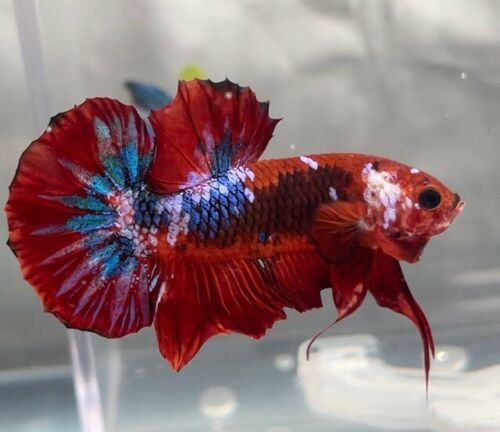
Koi fish under the betta category? Confusing, I know. However, if you love Koi but are short on huge space, then Koi bettas are the perfect pet for you!
Koi betta is not some variant of the Carp family, but a true betta fish with marble coloration that resembles the great Koi fish. The only big difference is they are much smaller in size and well suited for smaller tanks.
Appearance wise, Koi bettas are mostly white in color with a combo of black, red, yellow, or orange. However, in some rare cases, you might find unique color splotches, including blue and green.
Unlike most betta, Koi bettas are short-finned and are low-maintenance. You will often see Koi bettas with the desirable halfmoon tail trait in Plakats.
Dragon Scale
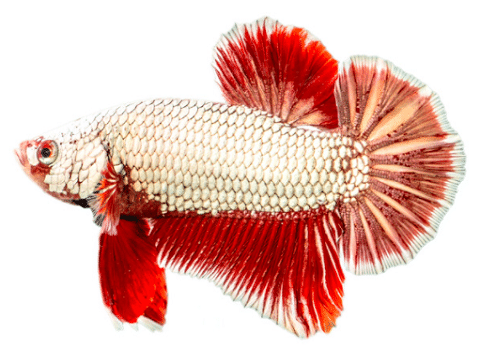
The dragon scale betta is a beautiful breed as a result of selective breeding. Nowadays, Dragon scale bettas are gaining more popularity because of their stoic appearance.
They have transparent scales with stunning metallic coloration and long flowing tails that drape like curtains in the water. But, because of excessive selective breeding, they may experience eventual blindness and other health problems. It is becoming one of the more controversial breeds to keep in the hobby.
Mustard Gas

If you want a showcase blue fish in your tank, go for mustard gas bettas because their long tails make and complimentary yellow tails pop. Because of their slow swimming behavior, they are an excellent choice for a nano tank as a sole species.
Mustard gas is a bi-colored fish that come in beautiful colors where the main color is mostly mustard combined with other striking colors such as blue, red, white, or yellow. Like their name, the behavior and temperament of Mustard gas are also very interesting.
Butterfly (Delta Tail)
The butterfly betta fish has one color that spreads throughout their bodies into the base of the fins. While the fins and tails of Butterfly bettas are mostly white or translucent.
When the fins of butterfly bettas are in full flare, you will notice that they have a two-tone color band on the outer half of each fin, which is a beautiful sight to witness.
Butterfly betta has many color varieties that make them the popular choice for aquariums. However, the most common variety is the blue half-moon betta fish.
Platinum
In a tank full of betta colors, all that shimmers is a platinum betta or white halfmoon betta fish. As the name suggests, Platinum bettas have a striking appearance with pearl-white bodies that gleam and beam in your aquariums.
Unlike the albino betta varieties, the Platinum betta has no traces of pink and displays a shimmery and metallic effect that beams in the dark.
Samurai
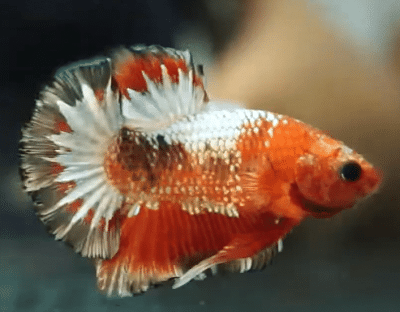
Samurai bettas are short-finned versions of Halfmoon that are easy to maintain and keep, but they require a little upkeep to be healthy and thrive in your fish tank. They are a variant of the Dragonscale and have a half dragon scale pattern. Like dragon scale bettas, they too can also suffer from blindness due to diamond eye.
Marble Dot
Marble dot bettas (video source) have translucent solid bodies adorned with unique marbling on their bodies. The marbling on these fish is a genetic flaw, but it is flawless and looks like a dream in the fish tank. They are available in both plakat and full halfmoon varieties.
Alien
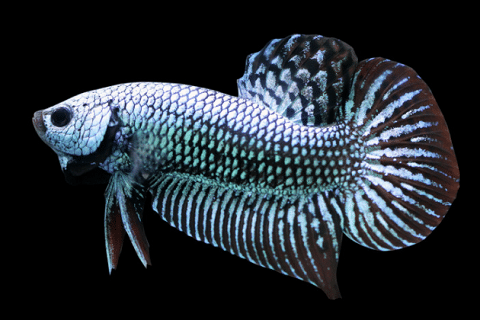
Alien bettas are not found in their natural environment because they are not wildly available. This fish is a result of crossbreeding two different types of betta fish in captivity. They have a black or dark body adorned with a metallic luster.
Temperament & Activity Level
As mentioned, the Halfmoon betta is a tropical fish species that does well in warm climate environments. These tropical fish are adapted to survive in water temperatures ranging from 72°-81° Fahrenheit (26- 28 degrees Celsius). However, all Betta prefer to be in temperatures of 76 – 78 degrees Fahrenheit
Despite the relatively warm water environment characterized by low dissolved oxygen, these fighting fish can rise to the water surface to breathe atmospheric air. This feat is made possible by the labyrinth organ that allows them to survive in low-dissolved oxygen tropical waters.
Consequently, the surface breathing ability makes betta fish one of the few species of fish that can survive in shallow water. This doesn’t mean you should keep them in a bowl long-term, though! Despite their hardiness, the Halfmoon betta thrives in fresh, soft water.
Ideal Tank Mates
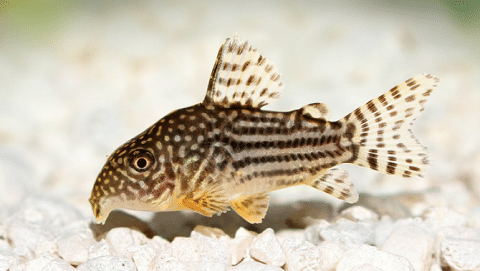
All Betta fish are territorial, especially the males. Males will set up a territory roughly two feet in length. Any fish that looks like them can be seen as a threat. This is something to remember if you want to keep your Betta with other fish.
Therefore, beginner aquarists need to do some research before choosing the ideal tank mates for them. Some of the best tank mates are:
I will note that Females are less aggressive, making the Female halfmoon betta suitable as a community fish. You will also increase your chances of success in a larger tank. Usually 20 gallon tanks will not have issues, especially if you opt for the 20 gallon long variant.
A classic 20 gallon aquarium in its 30 inch long variant. A very popular aquarium.
Food & Diet (What Do They Eat?)
Halfmoon betta is strictly carnivores and thrives on a protein-rich diet, derived from animal sources. In the wild, the Halfmoon betta normally feeds on mosquito larvae, small crustaceans, insects, and zooplankton.
In captivity, they thrive on a diet similar to their wild diet. Therefore, frozen foods, including bloodworms, black worms, brine shrimp, insect matter, daphnia, and other foods should be incorporated.
Best Betta Food
Fluval bug bites is made of various insect and shrimp ingredients making this a high quality source of protein
You can also give them live food (such as live brine shrimp) inside the tank to nurture their natural intuition to hunt. Many aquarists rely on commercial fish food for their Halfmoon betta, but careful selection should be made and mixing of foods should be done to encourage a balanced diet.
Tank Requirements
Here are some suitable tank requirements for Halfmoon bettas:
Temperature
Bettas are tropical fish and require a stable, warm environment. The water temperature should be maintained between 76-82 degrees Fahrenheit (24-28 degrees Celsius). If you live in a colder climate, you may need an aquarium heater to maintain this temperature range.
Best Aquarium Heater
Finnex has achieved what we as hobbyist have asked for decades. A reliable heater that won't fail. Japanese components. Receives our top recommendation.
Filtration
Bettas have a labyrinth organ, allowing them to breathe air, but they still benefit from a filtered tank. However, they prefer calm waters and can be stressed by strong currents. Thus, use a low-flow filter or adjust your filter’s flow rate to be gentle. Sponge filters are often a good choice for Betta tanks.
However, a proper filtration system for larger community setups should be provided because, like other fish, halfmoon betta also produces waste that pollutes the tank and may disturb the nitrogen cycle. For a larger tank set up, you can use hang-on-back or canister filters. Make sure to adjust the water flow, reduce the currents, and put a sponge on the intake for a smooth setup.
For aeration, because Halfmoon betta is labyrinth fish, the use of traditional air pumps or air stones is not needed. In a betta tank, if you provide too much surface agitation, there can be adverse effects on your fish.
Covered Tank
Bettas are known to jump, so a tank with a lid is important to prevent them from leaping out. However, ensure that there’s some gap between the water surface and the cover for the Betta to breathe air when needed. These fish are large enough that you could incorporate the use of mesh to cover the tank. You typically see this with a saltwater aquarium. However, this netting will not protect your other fish that are smaller, especially smaller schooling fish.
This mesh screen kit allows you to create your own custom mesh screen. Protect your fish from jumping with this screen. Does not affect your lighting and spread.
Decorations
Bettas like to explore and hide, so adding live plants, rocks, driftwood, and caves, can create a more enriching environment. However, avoid any sharp or rough decorations that could tear the delicate fins of your Halfmoon Betta. If you want to use artificial plants, consider using silk plants.
Lighting
Bettas do not require special lighting, but a moderate amount of light will help them follow a healthy day-night cycle. If live plants are used in the tank, they may need specific lighting requirements. If you want to keep a high tech high light setup, you will need to have darker areas for your Betta. Hides are helpful for this or having lots of plant density where your Betta can take shelter will be beneficial to them.
Water Quality
Bettas need clean water with a pH of around 7.0. Undetectable levels of ammonia and nitrites should be maintained. Nitrates should be kept below 40 PPM and can be regulated by making regular water changes and testing your water. Ensure to pre-condition the tap water to remove harmful chlorine before adding it to the tank.
Tank Size
Considering its small fish size and it’s ability to live in shallow waters, some newcomers to Betta fish keeping think it’s okay to place the in a bowl. That is not the best for their long-term health. Therefore, at least 5 gallons tank is recommended for a sole fish to keep them healthy. You will want to go to a minimum 10 gallons to consider other tankmates, which a 20 gallon tank being recommended for a community tank.
Aquatic Plants
Plants are essential elements to maintain any aquarium as they provide oxygen, regulate water quality and provide hiding places for your fish. However, due to the special water and tank requirements of betta fish, choosing aquarium plants are challenging.
Here are some of the best aquatic plants for your fish tank.
- Java fern
- Anubias Nana
- Marimo Moss balls
- Water sprite
- Amazon Sword
- Vallisneria
- Banana plant
- Java moss
- Anacharis
If maintaining the plants is a task for you, you can also choose plastic plants to give your bettas shelter without caring and worrying about the plants. However, choose plastic plants with smooth leaves to avoid any fin damage.
Substrate
For substrate, it is important to choose soft and smooth material that won’t damage your betta’s fins. Therefore, sand is the most viable option because it is smooth and soft. If you have live plants that need to be rooted down, provide a nutrient-rich substrate.
You can also opt for bare bottom without any substrate, as it will make it easy to clean the tank. However, this will limit your decoration and plant options, and tank decors and plants need substrate to root in. That being said, column feeding plants like Anubias are great for bare bottom style setups. Also, keep in mind that bare bottoms may also be a source of stress for a betta if they flare at their reflection. Consider putting a background on the bottom of the tank or painting the bottom to prevent this from occurring.
Differences Between Male And Females
For breeding purposes, it is important to differentiate between male and female halfmoon bettas carefully.
Luckily, unlike other fish, it is not difficult to differentiate between the two genders in Halfmoon bettas. Male halfmoon betta are aggressive and territorial, while female bettas can go along pretty well with other fish species.
Furthermore, male halfmoon bettas have brighter colors and beautiful long fins as compared to female bettas that have dull colors, though some specific breeds of female bettas will be colorful in their own right.
Fish Diseases
Halfmoon bettas, because of their beautiful and rather vulnerable long, flowing fins are more prone to fish diseases. Some of the common fish diseases found in Halfmoon bettas are:
Therefore, proper care with suitable tank mates and water parameters should be provided to keep the disease at bay. Many diseases are usually a result of injuries with Bettas. Parasitic diseases are usually a result of not quarantining or high stress levels in the tank.
FAQs
Are half-moon bettas rare?
Halfmoon bettas are not rare, but comparatively more challenging to breed and care for than their other betta counterparts. Halfmoon Plakat Bettas (HPMK) can be one of the more expensive bettas in the hobby if they have certain traits mixed with their halfmoon variety.
Are Half Moon bettas aggressive?
The male halfmoon betta can be particularly aggressive and territorial with other males. Therefore, two males should never be housed together in the same tank as a rule of thumb. You can place 2 males in a tank, but this is an advanced topic and requires a larger tank. If you want to know how to do this, check out our why bettas fish fight blog post.
What is the temperament of a Halfmoon betta fish?
The temperament of Halfmoon betta fish depends on a lot of factors, including the individual fish’s personality. However, in general, Halfmoon betta, like all bettas, are semi-aggressive and territorial.
Can a betta be happy in a 2-gallon tank?
No, due to their small size, many people believe bettas can survive in small jars or tanks. However, betta fish is an active species that need at least a 5-gallon tank for long-term survival.
How big does a Half moon betta fish get?
The Halfmoon betta is a small fish that can get around three inches in size.
What is the difference between Full moon and Half moon betta fish?
Half-Moon bettas have a single tail that extends to 180 degrees, whilst Full-Moon bettas are renowned for having a double tail that extends beyond 180 degrees. Full moon bettas achieve this look by having a double tail that has two half moons creating the full moon like appearance.
How long do halfmoon betta fish live?
In captivity, the average lifespan of halfmoon betta is two and four years. The length of life can be extended with a quality diet, a low stress environment, and excellent water conditions.
Final Thoughts
Halfmoon bettas are a beautiful, active member of the Osphronemidae family that is famous for their unique, stunning fins that drape gracefully as they swim in your home aquariums. They are easy to care for, provided that the tank conditions are taken care of, and a bigger tank is provided for their free-swimming behavior and hunting instincts.
Make sure to maintain tank conditions and water parameters in control to keep your Halfmoon betta healthy and in good health. Have you kept these Bettas before? If so, let us know in the comments! Until next time.
- About the Author
- Latest Posts
I’m thrilled that you found Aquarium Store Depot! Here you’ll find information on fish, aquariums, and all things aquatics related. I’m a hobbyist (being doing this since I was 11) and here to help other hobbyists thrive with their aquariums! I adhere to a high quality Editorial Process and Review products with real life field usage and practical analysis.


